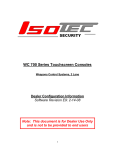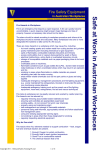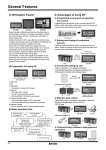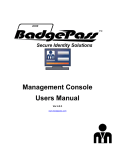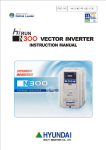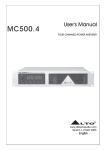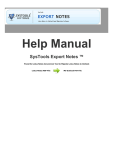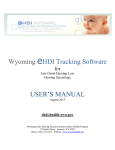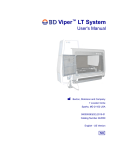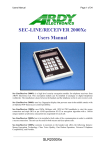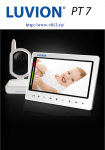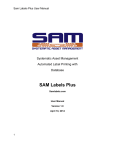Download Color Touchscreen USER`s Manual
Transcript
WC 700 Series Color Operator Console Operations Manual Weapons Control System, 2 Lane Software revision: G4: 8/1/12 Isotec Security Inc, st 6424 W. 91 Ave, Westminster, CO 80031 303-452-0022 www.isotecinc.com Operator Console Operation Manual This document describes the screen images and controls available in Isotec Security’s Second Generation Touchscreen Consoles, as supplied with various Weapons Control Portal products. This document reflects features supported in the G4 revision of the software; some features may not exist in earlier versions. Note that the G4 software only runs on FP0R controllers that were introduced with this software release, and cannot be used on older FP0 controllers. The use of the touch screen is quite intuitive and flows in a very predictable fashion. Each screen, and the various controls that show on that screen, are described in the following sections. MAIN SCREEN In normal operation, the Main screen will be displayed as follows: The outline on the screen represents the portal structure and doors, with the exterior (unprotected) part of the building shown on the right, and the entry lane shown on the top. Indicators are provided that show doors either open or closed, and whether a particular area is occupied. Also shown is a clock showing the current time. Please refer to the flowchart showing a typical entry sequence. The screen in the image above is shown with Entry and Exit lock switches hidden. page 2 V16 – 8/1/12 Normal Entry Sequence: The static (unoccupied) condition is when all four doors (A-D) are closed, and the B and D doors locked (#1 in the flow chart below). Note that when a door is locked and bonded, a red lock symbol shows by that door. The person entering will open the ‘A’ door then will move into the ‘A’ zone (nearest the outer door). A person symbol appears showing the occupancy of the ‘A’ zone (#2). As the ‘A’ door closes and the person moves toward the ‘B’ zone, he/she is evaluated by the metal detector in the center of the lane. If no metal is detected, the ‘A’ door will lock, the ‘B’ door will unlock (#3), and the user may open the ‘B’ door to enter the facility (#4). This sequence normally happens as a smooth, continuous transition, with minimum delays. Note that the ‘B’ door will not unlock until the ‘A’ door is closed and locked, the ‘A’ zone is unoccupied, and there is no metal detector alarm. An exit sequence (not illustrated) works in the same fashion, and symbols are the same as the entry lane. Operationally, once the ‘C’ zone is occupied and the ‘C’ door closes, the ‘C’ door will lock and will not unlock until the exit lane is completely unoccupied and the ‘D’ door has reclosed. The ‘D’ door will unlock once the ‘D’ zone is occupied and the ‘C’ door is closed and locked . page 3 V16 – 8/1/12 ALERT SCREENS There are five possible alert screens that may appear depending on various conditions that are described below. This chart shows the various screen examples: page 4 V16 – 8/1/12 Metal Detected Alarm: This will occur when someone moves from the ‘A’ zone to the ‘B’ zone carrying a metal object. The MD Alarm screen has a Red background, and is accompanied by a solid alert tone at the operator console, as well as a flashing red light inside the ‘B’ door. The operator then instructs the person (via the intercom) to place all metal objects in the inspection tray and walk back to the ‘A’ zone. After inspecting the contents of the tray using the overhead video camera, the operator will press the Clear Alarm button, resetting the alarm. The person can then move through the metal detector again to demonstrate that no additional metal is being carried. If no additional metal is detected, the ‘B’ door will now unlock as above. Optionally, the system can be configured to automatically reset when the entering person moves back to the ‘A’ zone. This option provides less security, but eliminates the need to have the operator manually reset the alarm. Please see your Isotec Dealer if you would like to consider this configuration. A box to the left of the portal symbol in the Metal Alarm mode may show the words “Possible Tamper”. In normal operation, this will never be displayed; however if tampering with the electronics cabinet is detected, this symbol will be shown. If this occurs, contact your dealer for troubleshooting. The alarm cannot be reset if tampering is detected. If the Auto Attendant function is enabled, the tones and operator actions will be different. Refer to the section below describing the Auto Attendant operation. page 5 V16 – 8/1/12 System Override: The System Override screen is displayed whenever one of the following events occur: Operator depresses the System Override button on the console; The Key Switch on the portal has been turned to the off position (red led); The building Fire Alarm system opens the contact across the fire alarm input. During System Override, all doors are unlocked, and the displays on the portal alternate red and green. System Override displays the FLASHING RED screen shown above at the operator console, accompanied by a solid alert tone. It can only be cancelled by resetting whatever caused it to occur (release the Emergency Release button, turn the Key Switch back on (green led), or end the Fire Alarm). There is a Mute button located on the screen. Pressing this button will disable the alarm tone. Once the Override is cleared, the Mute is automatically reset, and the tone will be heard again the next time Override occurs. You can also program the console to turn this alarm off automatically after 60 seconds using the Setup Screen (see below). Similarly, there is a button to disable the alternating red/green lights in the portal. This is typically used when the System Override button is used to disable the system during nonbusiness hours, and the user does not want the lights flashing at that time. As with the Mute button, this disabling is canceled when the Override is cleared. Note that during System Override, the metal detection is disabled. page 6 V16 – 8/1/12 Timeout Alarm is displayed on the screen if the portal is occupied for more than 45 seconds or any door is held open for more than 15 seconds. These are the default values and are adjustable by your Isotec Dealer. Either or both of these alarms can be disabled, or can be set to a different time, from the Dealer screens. A Timeout alarm can be cleared without clearing the underlying cause, at which point a new timeout will start if the portal is still occupied. A timeout alarm does not disable any normal system operations. It is accompanied by a Orange background, and an alternating alarm tone. Assistance Request This screen is displayed if someone outside the portal presses the optional Assistance Request button. It may be cancelled by pressing the Clear button on that screen, or will clear automatically after a 10 second timeout. The Assistance Request screen is shown with an orange background, with a short beeping tone. page 7 V16 – 8/1/12 The Emergency Release screen is only shown if the system is equipped with emergency release button(s) on the exit lane. In normal operation, if the ‘D’ door is operating properly, the ‘D’ door will unlock when someone approaches that door and the ‘C” door is closed. If there is some failure in the system and the ‘D’ door does not unlock correctly, or if there is a need to unlock the whole lane in an emergency, a person at the C door or in the exit lane can press an Emergency Release button. This will start a 15 second (30 second optional) time out, during which a horn will beep in that lane. After the delay, the ‘C’ and ‘D’ doors will be unlocked and the horn will sound continuously. Once the Emergency Release button is pressed, the console screen turns red, an alternating tone sounds, and “Emergency Release INITIATED” is displayed during the countdown. A bar graph showing the timeout remaining is also displayed. At the end of the 15 second time, the screen shows “Emergency Release ACTIVATED” (while the doors are actually unlocked). At this point, a RESET button appears on the screen. The doors will remain unlocked until reset by the system console (default configuration) or optionally can be set to relock automatically 8 seconds after being opened and then closed. This latter configuration may not be approved by local code authorities. Once the release is initiated, it cannot be cancelled by the portal occupant or the console operator. Please contact your Isotec Dealer for more information on Emergency Release configuration options. Alternate Timed Emergency Release: The System can also be configured with a timed release function, separate from the function invoked with the emergency release pushbuttons described above. There are two features to this time release. If this mode is enabled, if either the C or D door is held open for the Release Time (Default = 15 seconds), both doors in the exit lane unlock. Secondly, if someone becomes disabled in the C or D zone, and/or the D door does not unlock for some reason when the exit lane is occupied, after the Release Time, the D door will unlock automatically. page 8 V16 – 8/1/12 TROUBLESHOOTING & SETUP SCREENS This screen is reached by pressing the right arrow ( ) button on the main screen. This Control Screen provides access to the other diagnostic screens via the buttons on the left. These screens provide useful information and setup features. Additionally, this screen provides access to the dealer configuration screens which are used by your dealer for initial setup, via a special password. From each of these screens, you can return to the Main screen by pressing the left arrow symbol ( ) button. (note: On systems with the dual operator console option, the “Slave” console does not have access to the troubleshooting and setup screens. The right arrow on the Slave console only allows setting the clock.) The Diagnostic screen is reached by pressing the ‘diagnostic’ button on the Control screen. This shows a graphic similar to the main screen. In addition to the door, occupancy, and door bonded symbols (“bond” in a green oval) symbols, there is also a square with the work “lock” that shows if the door lock is powered. This can be useful in troubleshooting a failed component or installation problem. Also shown is a rectangle on the right side of the screen. If the system inputs are all in the condition they should be for the static mode, the words static ok shows in the rectangle. All of the following conditions are required for static ok to be displayed: page 9 V16 – 8/1/12 All doors closed; B & D doors locked and bonded; A & C doors unlocked and unbonded; no occupancy in any zone; no metal detector alarm. The I/O (Input/Output) List screen is reached by the ‘I/O list’ button on the Control screen. This brings up a display of all the inputs and outputs of the PLC, for troubleshooting purposes. Yellow Squares are located around the signals that should be on when the system is in the “static ok” configuration (unoccupied, all doors closed and locked properly). If any of these signals are off, or other ones are on, something is not operating correctly. Also on this screen (in software release G3 or newer) is a button to access the Self Test Mode. Self Test Mode Screen allows the operator to start a self test process by simply pressing one button on the screen and having someone walk through the entry and exit lanes. Pressing the “Start Self Test” button clears all the prior values. As the person walks through the portal, each device is tested, and if it is operational, the small square for that device turns dark. After a complete entry and exit, all the squares should show “on”. If any one does not turn on, that device has not cycled. They should illuminate in order, so the first one that does not illuminate is the likely failed component. The example below shows the screen at the start of self test, and a screen showing a successful entry zone test and a failed D zone occupancy sensor. In order to test the metal detector, a Manufacturer’s Test Piece should be carried during the entry test. The operator can clear the metal alarm from this same screen to complete the entry cycle. page 10 V16 – 8/1/12 The Statistics screen allows viewing various statistics associated with the system. Pressing the button brings up a table showing various event statistics: Entry Attempts is the number of times the A door has been opened (ie, someone entered the portal from the exterior door). This is a different value than the Customer Counter on the Setup screen, which is the number of times the B door has been opened. Metal Detector Valid Alarms is the number of times the metal detector has gone off when someone is inside the portal. MD Alarm per Entry Attempt is the percentage of the entries that resulted in a metal detector alarm. This may be helpful in determining the sensitivity settings on the metal detector. page 11 V16 – 8/1/12 MD Bypass Resets is the number of times that the operator clears a metal detector alarm when the B zone is occupied, letting someone in who may be unscreened. MD Bypass per Valid Alarm is the percentage of the Metal Detector Alarms that are cleared by an MD Bypass event. Completed Entries is the total number of persons that passed through the B door. This counter is separate from the Customer Counter on the Setup screen and is reset along with the other statistics. Aborted Entries is the number of times someone entered the entry lane, and turned around and left via the A door. This event would most likely occur when setting off the metal detector alarm, and the person leaving to remove additional metal objects. Metal Detector False Alarms is the count of times the metal detector went off when no one is in the portal. A high value here is generally an indication of external noise that should be corrected. Exit Lockdowns is the number of times that the Exit Lock function is invoked by the operator or via the remote switches. A button is provided on this screen to allow resetting the counters to zero. This button can be enabled or disabled from the dealer setup section. Default is enabled. The system can count up to approximately 30,000 events. In order to not display erroneous values, the system will “auto-reset” when the entry attempts counter gets to 30,000. The Setup Screen deals with the customer counter and alert, the entry alert tone, the automatic muting function, and setting the clock: page 12 V16 – 8/1/12 The color Touchscreen can be configured to sound an “alert tone” that emits a short beep from the console when the A door is opened. The button on the top left of this screen (shown as “OFF” in the view above) can be toggled on and off to enable or disable this beeping tone. The factory default is on. The Customer Counter totals the number of times the B door has been opened. This gives an approximation of the number of people that have passed thru the system. This counter can be reset by pressing the green Reset button located adjacent to the counter indication. This count IS maintained when power is removed from the system. The system can alert the operator when a specified number of entries has occurred. Toggling the Alert ON/OFF button enables this alert (the default is OFF). The trigger value can be set by touching the alert value box, and entering the new value on the keyboard that will appear. Hit the ENT key on the keyboard to set the new value into memory. When the counter reaches this value, the “Customer Counter” symbol will flash on the main screen Override Automute can be set OFF (Default) or ON. When this function is turned on, and the system goes into System Override, the alert tone will automatically mute after 60 seconds. The clock on the main screen is maintained when the power is removed from the system. This is sustained by an internal backup battery (CR2053) located in the rear of the display. The clock can be set by touching the blue Set Clock button on the top right of the screen, bringing up the clock screen. page 13 V16 – 8/1/12 Set the time and date by using the up and down arrows in each field. When done, press the SET button to set the time. Press the ESC button to return to the Setup screen Alarm Log brings up a screen that provides a historical record of various alarm indications and when they occurred. The Alarms that might be displayed, and their meanings, are as follows: Metal Detected – the metal detector has detected a metal object when the portal is occupied. Metal Detect – False Alarm – the metal detector has detected a metal object when the portal is not occupied. Timeout – either the portal was occupied too long or a door has been held open too long. The times for these timeouts can be set by your dealer. Override – whenever one of the override devices has been tripped. (see System Override above for those conditions.) Emergency Release – the emergency release button has been pressed. Possible Tamper – shows if the system thinks that the electronics cabinet has been opened. Power Up – time when power was applied to the system Exit Locked – the Exit Lock button has been pressed MD Bypass – an operator has cleared a metal alarm when someone was in the B zone. The normal procedure is to have the person move back to the A zone before clearing the alarm, so they can be rescreened after putting items in the inspection tray. The Alarm History screen has UP and DOWN buttons for scrolling up and down the history log. To erase the Alarm History, press and hold the Clear All button until the screen clears. The Alarm History screen stores the most recent 200 events, even if the power to the system is removed. page 14 V16 – 8/1/12 The Rev(ision)s screen displays the revision of the software in the Touchscreen and also displays the revision of the software loaded in the system processor. The Support info screen displays contact information for service on your system. Your dealer’s name and phone will appear where the asterisks are in this view: page 15 V16 – 8/1/12 LOCK BUTTONS Isotec Portals have the option to be configured so that doors can be locked from the Touchscreen, overriding the normal portal logic. This locking may or may not be allowed by local code authorities; your Isotec Dealer can assist you with determining if these features are allowed, & if so, can enable those desired. The functions available are Lock A door, Lock B door, and Exit Lane Lock If these features are enabled by your dealer, the screen lock buttons will be displayed as shown below: Switches hidden switches displayed The A door NORMAL and B Door NORMAL buttons each lock their respective door when touched. NORMAL indicates that the door locks work per the normal portal logic; LOCKED is displayed when the button is touched to lock the door. The following shows the A door locked with the top right button: Note that the A door button shows LOCKED, and also that the A door Lock/Bond symbol (the red lock) is displayed. The Exit NORMAL button on the lower left may be used to detain someone in the exit lane. If this button is depressed, then the C door will remain unlocked until someone enters the exit lane. Once C door closes with the exit lane occupied, the C door will lock, and the D door will page 16 V16 – 8/1/12 remain locked, rather than unlocking as it would in a normal exit. Thus the occupant of the lane is trapped until the Exit Lock button is toggled back to Normal. Once the Exit Lock is turned off, the occupant can leave via the D door. In addition to locking the Exit lane, the system can be configured to also lock either the A door, the B door, or both, when the Exit Locked button is engaged. Your dealer can configure this option for you. B Door Momentary Unlock Your system has the option to allow the operator to unlock the B door temporarily to allow someone inside the building to enter the portal at that door to assist someone, such as a person in a wheelchair who cannot move far enough through the metal detector to avoid a metal alarm. It is NOT to be used to let someone exit from the portal via the B door after setting off the metal alarm – that should be done by clearing the metal alarm. The default for this function is “off”, so if it is required in your application, please ask your dealer to enable the function. The B Door Unlock is performed by pressing and holding the B Door Lock button. After two seconds, the B door will unlock (and the A door will lock if it is closed) and will remain unlocked as long as the button is held. The “B door unlock” can also be operated via the right button on a wireless remote (see below). This button must be held for 10 seconds before the door will unlock, and will stay unlocked as long as the button is held. AUTOMATED ATTENDANT The system can be configured for Automated Attendant operation by your dealer. Certain portions of the Automated Attendant function are optional When the Automated Attendant is in operation, a banner will appear on the console screen: The Automated Attendant feature allows reduced operator workload. It should only be used in conjunction with the voice prompt option alerting the occupant as to what action to take in the page 17 V16 – 8/1/12 case of a metal alarm, and it is recommended that the High Zone Left Object Detection option also be installed. The operation is as follows: If an individual enters the entry lane and triggers the metal detector, they will hear a voice prompt that instructs them to turn around, exit the portal, remove all metal objects, and reenter the portal. Once the individual exits the portal, both doors are closed, and no occupancy is detected, and no objects are detected in the high zone, the metal alarm is cleared, allowing the next person to enter. The console operator will see the metal detector alarm screen, and will hear an alternating tone. The alternating tone will continue when the person proceeds to exit the portal, and ends when the alarm is automatically cleared. If the person remains in the B zone after the voice prompt for 6 seconds, the tone at the console will change to a solid tone, alerting the operator that action is required. At this point, the operator would need to contact the occupant via intercom to provide further instructions or resolve the situation. If an “left object” (i.e., a weapon) is detected in the B zone after a person exits the portal via the A door, the alternating tone will continue for about 6 seconds, then will turn to a continuous tone, alerting the operator that something has been left behind and action is required. The Metal Alarm will not be reset automatically if a left object has been detected. When a left object is detected during a metal alarm, a yellow flashing symbol and a warning text box is displayed adjacent to the Metal Detector Alarm symbol. Note that the Left object detector will not only detect objects on the floor, but will also trigger if someone is still standing in the B zone. : After the portal is empty and the Left Object alarm occurs, the operator should manually lock the A door via the A Door button, evaluate what is left in the portal via the video monitor or direct inspection, and remove the offending object before clearing the metal alarm. As part of the Automated Attendant feature set, a second voice prompt is available. If someone enters the portal and remains in the A zone, or two people enter and one remains in the A zone, after 5 seconds, a voice message is played telling the person to move forward through the metal detector. This eliminates the requirement for an operator to direct people in this situation. page 18 V16 – 8/1/12 CREDENTIAL RESET: As a further method to reduce operator workload, the portal also has the capability to be outfitted with a Credential system (card reader/pin device and/or biometric reader) that can be configured to allow a person entering the portal who set off the metal detector to clear the metal alarm by presenting their credentials. These credentials would of course only be given to “trusted” individuals who the facility wishes to enter the facility with metal objects. The operation requires no action on the part of the system operator; the entrant simply presents the credential after passing through the metal detector (if an alarm is triggered). The Alarm resets and the person can continue through the portal. This system is often utilized in conjunction with the Automated Attendant feature to reduce operator interaction to almost zero. REMOTE TRANSMITTERS: Isotec offers the options of either single or two button remote control transmitters, which allow certain functions to be implemented without having to go to the operator console. This might be useful for other officers in the bank to operate the system in parallel with the console operator. The single button remote, or the left button on a two button remote, is used to clear the metal detector alarm. Depressing that button and holding it for 1 second (to prevent inadvertent presses) ends the alarm immediately. At that point, the portal will work normally (for example, the B door will unlock if all the normal logic conditions are met) On the two button remote option, the right button function is programmable by your Isotec Dealer. The functions available are: A door Lock B door Lock Entry Lock (both A and B doors locked) Exit Lock (same operation as the Exit lock on the Touchscreen) Release All (same function as depressing the Override button on the console – releases all doors.) In the case of the first four functions, the operation of the button is “alternate action” – in other words, the first press turns on the function (hold for 1 second – a flashing red light indicates the remote has triggered and you can release the button), and the second press turns off the function. Note that if one transmitter is used to turn on the function, either that transmitter or another transmitter can be used to turn off the function. There is an indicator on the Operator Console that shows when the function is toggled “ON” as shown by the words “Remote On” and the purple diamond on the screen example below. Note also the diamond next to the A door lock symbol, indicating that is what the remote is controlling: page 19 V16 – 8/1/12 In the case of the Release All function, the remote button acts as a momentary push button (it does not latch as the other functions do). In order to preclude inadvertent operation of the Release All function, this button must be held depressed for 1.5 seconds before the doors release. This button must then be held down to keep the doors released. Holding this button will only hold the doors open for about 10 seconds and is only intended for a temporary door release. If the system needs to be overridden for a longer time period, use the OVERRIDE button on the Operator Console. Similar to the “B” door touchscreen button, if the “Unlock B” remote function is selected, and the “B unlocks after hold 10 seconds” setting is enabled, the right button on the remote can be used to unlock the B door as well. When using the remote to unlock the B door, the button must be depressed for 10 seconds, to avoid inadvertent unlocking. The door will remain unlocked as long as the button continues to be held. Note that the red indicator light on the remote will stop flashing after about 3 seconds of pressing. The default for the “unlock after hold-remote” is “Disabled”. EXTERNAL CARD INPUTS: The system has the capability to be wired to one or more external contacts that can be used to unlock various doors or lanes. This would be wired by your dealer as part of the installation. These inputs could be used for external card readers or as a remote “override” capability. The inputs available are: A door Card in B door Card in Exit Lane Unlock in Each of these inputs uses a dry contact closure input to activate the function. Closing the contact for the “A door Card in” unlocks the A door for as long as the contact is maintained. Similarly for the other two inputs. To unlock multiple doors, the external contact(s) can be wired to multiple inputs in parallel. For example, wiring the A and B card input’s together unlocks the whole entry lane. When one of these inputs is active, a symbol shows on the main screen and/or the System Override screen indicating that one of the inputs is on: page 20 V16 – 8/1/12 If both the A door unlock and the B door unlock switches are closed, the metal detector alarm is turned off until either or both of the switches reopen. page 21 V16 – 8/1/12






















